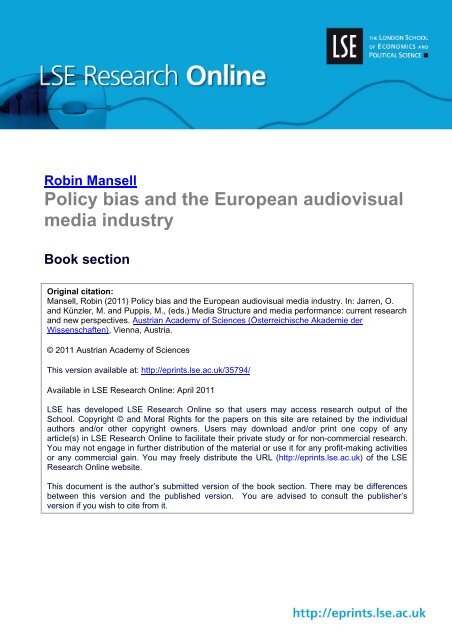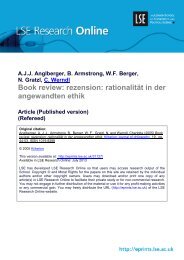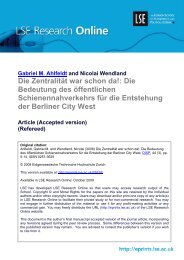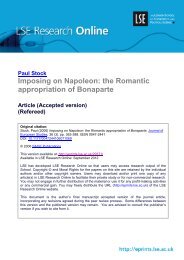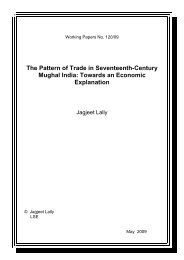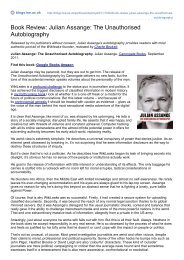Download (307Kb) - LSE Research Online
Download (307Kb) - LSE Research Online
Download (307Kb) - LSE Research Online
You also want an ePaper? Increase the reach of your titles
YUMPU automatically turns print PDFs into web optimized ePapers that Google loves.
Robin Mansell<br />
Policy bias and the European audiovisual<br />
media industry<br />
Book section<br />
Original citation:<br />
Mansell, Robin (2011) Policy bias and the European audiovisual media industry. In: Jarren, O.<br />
and Künzler, M. and Puppis, M., (eds.) Media Structure and media performance: current research<br />
and new perspectives. Austrian Academy of Sciences (Österreichische Akademie der<br />
Wissenschaften), Vienna, Austria.<br />
© 2011 Austrian Academy of Sciences<br />
This version available at: http://eprints.lse.ac.uk/35794/<br />
Available in <strong>LSE</strong> <strong>Research</strong> <strong>Online</strong>: April 2011<br />
<strong>LSE</strong> has developed <strong>LSE</strong> <strong>Research</strong> <strong>Online</strong> so that users may access research output of the<br />
School. Copyright © and Moral Rights for the papers on this site are retained by the individual<br />
authors and/or other copyright owners. Users may download and/or print one copy of any<br />
article(s) in <strong>LSE</strong> <strong>Research</strong> <strong>Online</strong> to facilitate their private study or for non-commercial research.<br />
You may not engage in further distribution of the material or use it for any profit-making activities<br />
or any commercial gain. You may freely distribute the URL (http://eprints.lse.ac.uk) of the <strong>LSE</strong><br />
<strong>Research</strong> <strong>Online</strong> website.<br />
This document is the author’s submitted version of the book section. There may be differences<br />
between this version and the published version. You are advised to consult the publisher’s<br />
version if you wish to cite from it.
Policy Bias and the European Audiovisual Media Industry<br />
By<br />
Professor Robin Mansell<br />
Department of Media and Communications<br />
London School of Economics and Political<br />
Science<br />
Email: r.e.mansell@lse.ac.uk<br />
18 April 2011<br />
Chapter prepared for Media Structure and Media Performance: Current <strong>Research</strong> and New<br />
Perspectives, edited by O Jarren, M Künzler and M Puppis, for publication by Austrian Academy of<br />
Sciences (Österreichische Akademie der Wissenschaften), Vienna, forthcoming 2011.
Policy Biases and the Europea n Audiovisual Media Industry<br />
‘Changes in media structure and media policy, whether these stem from economic developments<br />
or from public intervention, are properly political questions of as much importance as the<br />
question of whether or not to introduce proporti onal representation…’<br />
(Garnham, 1990: 104)<br />
Introduction<br />
This quotation from Nicholas Garnham’s book on Capitalism and Communication leaves<br />
little doubt about the importance of media policy for a democratic society. i In the late<br />
1980s, the European Union’s Television without Frontiers Directive implicated media<br />
services in the project of building a competitive European common market, albeit<br />
‘without prejudice to the public interest role to be discharged by television broadcasting<br />
services’ (European Commission, 1989: 1). The tension between the values of<br />
commercial and public service broadcasting was already apparent. More than two<br />
decades later, the contests between the economic and the political and cultural<br />
ambitions for the audiovisual media industries, are ongoing (European Commission,<br />
2010b).<br />
A particular vision of the information society serves as a focusing device for European<br />
policy with respect to the audiovisual media industries. This is a vision which privileges<br />
technological innovation and competition as the primary means of ensuring a vibrant<br />
market for the production of media content (European Commission, 2010b; Mansell and<br />
Steinmueller, 2000). This has implications for the structure of the media industries in<br />
Europe because it gives priority to the workings of the marketplace which, in turn,<br />
influences the performance of both the private and public components of the<br />
audiovisual<br />
media sector.<br />
In this chapter I discuss the vision of the information society that serves as backdrop to<br />
audiovisual media policy, briefly explain the historical structural separation between<br />
broadcasting and telecommunications, and then consider the bias of policy in the<br />
audiovisual sphere, concluding that policy is inconsistent with the industry performance<br />
required for a media sphere that is consistent with the requirements of democratic<br />
societies.<br />
2
Frictions in Audiovisual Media Goals<br />
Audiovisual media rely on digital technologies as platforms for their production,<br />
distribution and consumption. A quotation from the European Union’s Audiovisual<br />
Services Directive (AVMSD) emphasises the centrality of digital technologies in the<br />
changing landscape of audiovisual services. The Directive refers explicitly to structural<br />
change and competition as the optimal conditions for the sector. Respect for cultural<br />
and<br />
linguistic diversity is mentioned at the end of this clause, almost as an afterthought.<br />
‘In the light of new technologies in the transmission of audiovisual media<br />
services, a regulatory framework concerning the pursuit of broadcasting<br />
activities should take account of the impact of structural change, the spread of<br />
information and communication technologies (ICT) and technological<br />
developments on business models, especially the financing of commercial<br />
broadcasting, and should ensure optimal conditions of competitiveness and legal<br />
certainty for Europe’s information technologies and its media industries and<br />
services, as well as respect for cultural and linguistic diversity’ (emphasis added)<br />
(European Commission, 2010c: para 4).<br />
The AVMSD refers to cultural services. These are implicated in democracy and in the<br />
goals of ensuring freedom of information, diversity of opinion and media pluralism, but<br />
it also brings these goals into contention with the aims of fostering growth and jobs in<br />
the information society (European Commission, 2010c: para 14). The AVMSD refers to<br />
the Convention on the Protection and Promotion of the Diversity of Cultural Expressions<br />
(UNESCO, 2005: Art. 2(5)) which states clearly that ‘the cultural aspects of development<br />
are as important as its economic aspects, which individuals and peoples have the<br />
fundamental right to participate in and enjoy’. Unfortunately, this equivalence recedes<br />
in the Commission’s treatment of the audiovisual sector when it comes to assessments<br />
with<br />
regard to its competitiveness.<br />
The Directive covers ‘mass media’, that is, television broadcasting and on‐demand<br />
services ‘which are intended for reception by, and which could have a clear impact on, a<br />
significant proportion of the general public’. It excludes ‘private websites and services<br />
consisting of the provision or distribution of audiovisual content generated by private<br />
3
users for the purposes of sharing and exchange within communities of interest’<br />
(European Commission, 2010c: para 21). While the content produced by private<br />
individuals is outside this policy framework, other content production – regulated and<br />
unregulated – is seen as a key component of the European project of developing markets<br />
that can compete on the world stage. The audiovisual media sector is expected to<br />
contribute substantially to building a competitive European information society. As<br />
Pouwels and Donders (2011) point out, recent years have seen major changes in the<br />
focus of audiovisual policy in Europe. The media service provider is now defined as ‘the<br />
natural or legal person who has editorial responsibility for the choice of the audiovisual<br />
content of the audiovisual media service and determines the manner in which it is<br />
organised’ (European Commission, 2010c: Art 1d). This excludes, for the present,<br />
telecommunication operators, and the print and publishing industries, but all the<br />
commercial providers are seeking audiences and advertising or subscription revenues.<br />
Theoretically, they are all expected to compete on a level playing field, a field that should<br />
not be distorted by publicly supported organisations in the sector, that is, those charged<br />
with<br />
public interest obligations.<br />
This friction between the cultural and economic ambitions for the audiovisual media<br />
sector in Europe is captured in a European Commission discussion document on the<br />
development of the market for creative content in Europe. Here it is asserted that ‘the<br />
online distribution of creative content in the EU has the potential to create more choice<br />
and diversity for consumers, new business models for commercial users and more<br />
sustainable growth for rightholders’ (European Commission, 2009b: 1). The tension is<br />
between those who benefit from the relative scarcity of digital content which can be sold<br />
in the commercial market and citizens who may benefit from the broadest availability of<br />
such content in line with the information requirements of democratic societies. With the<br />
changes in the structure of audiovisual media industries over the past two or more<br />
decades, policies aimed at creating a competitive marketplace for audiovisual media,<br />
while preserving cultural diversity and safeguarding media pluralism, stand in<br />
contradiction<br />
to each other.<br />
Information Society Biases<br />
In the information society, competition is the predominant value. This is not surprising<br />
given the value of the information and communication technology (ICT) sector as a<br />
whole. Total ICT spending worldwide was estimated at USD 3,398 billion in 2009. North<br />
4
America accounted for 30 per cent of this, with Western Europe accounting for a further<br />
30 percent. Of this spending 50 per cent was on communication services and hardware<br />
(OECD, 2010). The spending on ICTs contributes to the output of creative content where<br />
the audiovisual media play an important role. On a worldwide basis in 2008, UNCTAD<br />
ut the value of the creative ‘economy’ at USD 406,992 million. ii<br />
p<br />
In Europe, the creative industries in the 27 European Union countries are estimated to<br />
have generated some 560 billion Euros in value added in 2008, or 4‐5 per cent of total<br />
GDP, iii and to have accounted for about 6.5 per cent of the total European Union<br />
workforce. The biggest players in the world media markets are Time Warner, Walt<br />
Disney, Comcast, News Corp, DirecTV, NBC Universal, Viacom, Echostar, Liberty Global<br />
and CBS. The structure and performance of the European audiovisual markets<br />
inevitably become issues for policy in the face of this global competition. As the<br />
European<br />
Commission’s report on industrial competitiveness for 2010 states,<br />
‘The economic rationale for government intervention in favour of the creative<br />
industries starts from the notion that this sector constitutes a significant locus of<br />
economic dynamism in the post‐industrial world. This view evaluates cultural<br />
events, institutions, and creative activities according to their significance for, or<br />
their positive contribution to, the aggregate economy’ (European Commission,<br />
2010d: 222)<br />
Coupling audiovisual media with the information society doctrine of competitiveness<br />
creates a bias towards investing in technological innovation and boosting the<br />
production, transmission and consumption of digital information. The fact that<br />
information, and media content in particular, has symbolic meaning and is important for<br />
cultural diversity and democratic conduct is not a component of this doctrine. This<br />
absence is consistent with the post World War II efforts to develop new information and<br />
control systems (Wiener, 1948/1961). While the technologists and mathematicians<br />
were developing the technologies that would become the precursors to the digital<br />
systems of today, economists were attracted by mathematical depictions of information<br />
control systems. They soon shifted from modelling information transmission systems to<br />
examining the impact of these systems on the economy. They struggled with the<br />
challenges of modelling the immaterial characteristics information as compared to<br />
material goods, but they were concerned principally with market relationships for the<br />
production and consumption of information. iv They realised that if markets in digital<br />
5
information were to grow, information resources must be perceived to be scarce. v<br />
When information society services, including audiovisual media services, are examined<br />
in this market oriented framework with its focus on scarce resources and the price<br />
system,<br />
there is no scope for a consideration of cultural issues of plurality or diversity.<br />
The information society vision took hold of the popular imagination in the 1990s and<br />
the political classes quickly picked up the message with Vice‐President Al Gore<br />
promoting the information highway in the United States and internationally and Martin<br />
Bangemann doing so in Europe (European Commission, 1994; Gore, 1993). Analytically,<br />
innovations in ICTs were associated with a change in ‘techno‐economic paradigm’<br />
resulting from the declining cost of storing, processing, communicating and<br />
disseminating information (Freeman and Soete, 1994). These changes in the role of<br />
ICTs would transform all sectors of the economy, and the audiovisual media services<br />
sector would not be an exception. The pressure would grow to ensure that policy would<br />
favour the operation of a competitive market in Europe for audiovisual media services,<br />
with increasingly less concern for the variety of purposes associated with the<br />
production<br />
of digital media content.<br />
Structural Transformation and Convergence<br />
A link between the structural composition and dynamics of this industry and its output<br />
has long been assumed to exist, even if there are disputes about whether media<br />
diversity and plurality can be achieved best as a result of market competition, through<br />
policy intervention, or a combination of both. McQuail (2005: 277), for example, states<br />
that market structure has important implications for ‘the type and amount of media<br />
content produced and offered to audiences’. The issue is whether, in a convergent ICT<br />
marketplace characterised by both ‘competition‐enhancing and competition‐reducing<br />
effects’ (Bauer, 2005: 80‐81), public interest goals are likely to be achieved. Studies in<br />
the political economy tradition, consistently posit a link, however indirect, between<br />
market structure and output based on empirical research addressing issues of labour,<br />
ownership,<br />
the mode of production, and regulation.<br />
The structure of media production is assumed to be intimately related to the<br />
consumption of symbolic content and the consequences for democratic participation in<br />
society (Garnham, 1990). Unlike the neoclassical framework in economics where<br />
existing distributions of power are assumed to be given or unalterable (Melody, 1994),<br />
6
in the political economy tradition, the challenge is to investigate the link between<br />
markets and the media’s output in a given historical period. The dimensions of power<br />
relationships are examined although it is usually acknowledged that there is no<br />
‘necessary coincidence between the effects of the capitalist process proper and the<br />
ideological needs of the dominant class’ (Garnham, 1986: 23). Attention focuses on the<br />
strategies of the dominant firms in a given market. Until the 1990s when the<br />
convergence of ICTs started to become a significant feature of the industrial structure of<br />
the audiovisual media sector, the policy focus for broadcasting was distinctly separate<br />
from the focus of policy in the complementary telecommunication industry which was<br />
also<br />
experiencing enormous change in the wake of the ICT paradigm.<br />
The media content and telecommunication (computing) industries were structurally<br />
separate historically. In the former, policy was mainly concerned with radio and<br />
television, issues of ownership and the public interest. In the latter, the focus was on<br />
infrastructure, networks and services and their economic characteristics and<br />
performance<br />
in the marketplace.<br />
The idea that a competitive international market should emerge for telecommunication<br />
services with the goal of stimulating innovation in the sector and enabling the global<br />
spread of networks and advanced digital services took hold in the 1980s (Ergas, 1985;<br />
Mansell, 1989). Debates about market liberalisation culminated in trade liberalisation<br />
which set the stage for market liberalisation at the regional level in Europe and around<br />
the world (Bressand, et al., 1989). Policy began to focus on the capacity of nationally<br />
based telecommunication operators to respond to the challenges of digital technologies.<br />
The commitment to trade liberalisation was reflected in the global information<br />
infrastructure initiatives and the policy mantra was privatise, liberalise, compete. This<br />
‘western liberalisation model’, originating in the United States, was then exported<br />
worldwide<br />
(Mansell, 1992).<br />
In media markets, defining the public interest in broadcasting had always been a<br />
challenge (Blumler, 1992; Melody, 1990). Some argued that greater play of market<br />
forces would stimulate content production, claiming that broadcasting policy had been<br />
ineffective in generating public services responsive to the interests of the majority of<br />
citizens (Collins and Murroni, 1996). Most analysts argued, however, that in the face of<br />
changing technologies, policy measures would be needed to secure the future of public<br />
service broadcasting (PSB) in a competitive era (Curran and Seaton, 1997). Debates<br />
7
about policy were politically charged because of the links between market structure,<br />
media<br />
freedom and democracy.<br />
Comparative accounts of changing policy regimes for media showed that adjustments to<br />
the ICT paradigm had not been uniform (Hallin and Mancini, 2004; McQuail, 2002;<br />
McQuail and Siune, 1999; Venturelli, 1998). At the beginning of the 2000s, Verhulst<br />
(2002) argued, nevertheless, that there had been a paradigm shift in digital content<br />
regulation. ICT convergence had provided a new basis for many‐to‐many distribution,<br />
non‐linear programming, and the transnationalisation of media markets. With the<br />
development of many new digital platforms, followed by mobile and Internet access to<br />
media content, the competitive broadcast market model had also been exported<br />
globally. The bias of policy was to foster the competitiveness of firms in the audiovisual<br />
sector. As Hamelink (1996) observed, the result would be disempowering as the<br />
prospects of media producers with an explicit public service mandate waned in most,<br />
though not all, countries. This was so despite the proliferation of user generated content<br />
enabled by the digital revolution. Technological convergence has fostered industry<br />
convergence and policy convergence such that the greatest emphasis is on competition<br />
and<br />
innovation, consistent with the prevailing information society vision.<br />
In the context of information society developments, the spread of networks and new<br />
online applications has been associated with a flattening of hierarchies, the<br />
disappearance of capacity constraints, and empowered consumers. The bias in<br />
audiovisual media policy has been a presumption of fair competition as the guarantor of<br />
the public interest in media content. However, from a political economy perspective, the<br />
mere manifestation of competition in a given market is insufficient evidence of a<br />
weakening of the interests of firms in responding to the profit motive. Market power is<br />
associated with strategies that enable oligopolistic firms to entrench their positions,<br />
even in the face of destabilising change associated with a new techno‐economic<br />
paradigm. Firms in the audiovisual media market have incentives to monopolize the<br />
market by controlling its ‘choke points’ or gateways (Anderson, 2010; Mansell, 1996). As<br />
Noam, comments, in the face of the declining costs of digital equipment, ‘one major way<br />
for companies to deal with this price deflation is to try to reduce price competition. An<br />
oligopolistic market structure helps’ (Noam interviewed by Gassot, 2005: 153). When<br />
these firms succeed in creating a perception of scarce resources, this inevitably gives<br />
rise to implications for media diversity. The case of the expansion of the Murdoch News<br />
Corporation empire in the United Kingdom with its proposed acquisition of shares in<br />
8
BSkyB, even if it requires the spin‐off of some holdings in the news market, is<br />
symptomatic of the strength of the market ethos in the European audiovisual sector. The<br />
significance of market dominance as a public policy issue does not simply fade away in<br />
the<br />
face the spread of the technologies of the information society.<br />
Evidence on the Supply Side: The strategies of firms to dominate markets with anti‐<br />
competitive consequences are evidenced by legal proceedings initiated under<br />
competition policy rules. In the United States, for instance, the Department of Justice<br />
has been examining Google Ads for its possible anti‐competitive implications in<br />
diverting market share from Yahoo! vi and Comcast has been charged with trying to<br />
establish an Internet video ‘toll booth’, vii In the Microsoft case in Europe, the company<br />
was found to have abused its dominant position in the personal computer operating<br />
system market by refusing to disclose interoperability information, preventing<br />
innovative products from being brought to market and distorting competition in the<br />
streaming media market (European Commission, 2007). The European Commission<br />
recently has started an antitrust investigation into allegations that Google, which has a<br />
95 per cent share of the European search engine market, is abusing its dominant<br />
position in online search. This case is focusing on whether Google lowers the ranking of<br />
unpaid search results of competing services. It is also investigating whether Google’s<br />
exclusivity obligations prevent advertising partners from placing ads with other<br />
platforms (European Commission, 2010a). In these cases, the question is whether the<br />
market structure enables firms to restrict access to essential resources, thereby<br />
restraining the capacity of others to compete fairly and disadvantaging consumers by<br />
restricting<br />
choice.<br />
Evidence on the Consumption Side: There are structural asymmetries in the composition<br />
of ‘user/audience’ communities as well. The information society vision plays an<br />
important role here by diverting attention towards the opportunities available as a<br />
result of social media platforms. Relatively homogeneous communities of empowered<br />
content producers (prosumers) are seen to be engaged in blogging and social<br />
networking, generating content without restraint. The structure of the market is seen to<br />
facilitate a plural, open information commons. An undifferentiated notion of the ‘user’<br />
shifts attention away from firms that are dominating the market. ICT convergence is said<br />
to be consistent with values of inclusiveness and democracy or the ‘wisdom of crowds’<br />
(Benkler, 2006; Surowiecki, 2004). However, these same platforms also are being used<br />
for citizen surveillance. Internet websites can be, and often are, blocked; mobile<br />
9
networks can be shut down. A political economy perspective on these developments<br />
suggests that while ‘audiences’ are comprised of globally networked users who appear<br />
to derive pleasure from social networking, new forms of immaterial labour performed<br />
passively using Facebook or actively using Amazon’s Mechanical Turk are offering firms<br />
a basis for targeting their content in ways that are inconsistent with a level competitive<br />
playing field (Coté and Pybus, 2007), and that are unrelated to the symbolic content of<br />
the<br />
media.<br />
What kind of mediated public sphere?<br />
Concerns about the transformation of the audiovisual media industries are connected<br />
with prevailing ideas about the relation between a mediated public sphere and<br />
democracy (Calhoun, 1992). In the Habermasian public sphere, a democratic polity<br />
emerges as a result of the quality of discourse and the level of participation. The<br />
mediated environment is expected to create spaces for consensus formation. In contrast<br />
to this view, Mouffe (1999: 746) argues that this conception of the public sphere<br />
downplays the contested interests of citizens. It ‘consists in replacing the market‐<br />
inspired view of the public sphere by another conception that conceives political<br />
questions as being of a moral nature and therefore susceptible of being decided<br />
rationally’. She suggests that the public sphere should be structured so as to<br />
acknowledge diversity and difference, to allow passionate debate, and to provide for<br />
conflicts<br />
among adversaries to be expressed.<br />
In this view, the interpenetration of the audiovisual media with democratic processes<br />
suggests that mediation has the power to frame issues, to prime people through<br />
cultivation and to engage in agenda setting. As Silverstone (1999: 143) observed, ‘it is all<br />
about power, of course. In the end’. In this context, therefore, there is little doubt that<br />
the structure of the media matters – if it squeezes spaces for the contestation of views in<br />
the interests of profit or in the interests of the state, policy measures are needed which<br />
are not based primarily on issues of market share and commercial performance.<br />
A consequence of the information society vision as indicated above is the bias towards<br />
markets. Although content regulation has not been abandoned completely it is discussed<br />
in terms of market value (Tambini and Cowling, 2004). The result is that the European<br />
Commission requires Member States to use ‘public value tests’ and market impact<br />
assessments to determine the scope of activities of public service broadcasters. viii The<br />
10
consequence is that these broadcasters have to quantity the ‘value added’ they<br />
contribute in the face of opposing claims by commercial broadcasters (Donders and<br />
Pauwels, 2008). The content produced is being monetized. Any new service must take<br />
account of the impact of that service on ‘trading conditions and competition’ (European<br />
Commission, 2009a: 20). Public funding of new audiovisual services must not ‘distort<br />
trade and competition to an extent contrary to the common interest’ (European<br />
Commission, 2009a: 21). The provision of public service content is sometimes even<br />
seen as chilling the entry of providers in the commercial market (Collins, 2002).<br />
However, as Freedman (2008: 157) argues ‘the effort to quantify the value of PSB<br />
services fails to see broadcasting as a complex social and cultural practice’. The role of<br />
policy becomes that of curtailing the ‘monopoly power’ of public service broadcasters,<br />
placing assessments of their performance squarely in a market context.<br />
Conclusion<br />
Technological convergence in the ICT sector has provided the principal justification for<br />
the transformation of audiovisual media markets and for the decline of public service<br />
broadcasting. Policies at all levels call for competition to release the potential of digital<br />
technologies. Melody (1989: 29) asked, what will become of ‘public interest’<br />
considerations in information societies governed principally by market forces? He<br />
suggested that ‘to begin the process of redefining the public interest in the information<br />
society, it is necessary to return to the essential functions of information and<br />
communication in modern participatory democracy, that is, to provide opportunities for<br />
citizens to be informed and to be heard’. Unfortunately, we find increasingly that, ‘the<br />
European viewer has gone from being a silent citizen in the state monopoly era to a<br />
valuable consumer in the digital era of private oligopolies’ (Papathanassopoulos, 2002:<br />
251).<br />
Audiovisual media policy has become interchangeable with policies aimed at the<br />
enforcement of market relationships through the commodification of information,<br />
including media content. The use of terms like ‘creative industry’ or ‘information society’<br />
serves to disguise the contradictions that arise when the policy thrust is to encourage<br />
technological neutrality and platform independence with the expectation that this will<br />
foster competition. The inevitable conflicts call for critical investigation of the links<br />
between media market structure and the performance of the audiovisual media<br />
industry, even as the information society gives rise to multiple platforms for<br />
11
contributing media content. They also call for policy proposals that give greater weight<br />
to the contribution of the audiovisual media to the democratic process.<br />
References<br />
Anderson, C. (2010) 'The Web is Dead: Long Live the Internet ‐ Who's to Blame: Us'.<br />
Wired, September,<br />
1‐17.<br />
Arrow, K. J. (1984) The Economics of Information. Oxford: Blackwell.<br />
Bauer, J. M. (2005) 'Bundling, Differentiation, Alliances and Mergers: Convergence<br />
Strategies in U.S. Communication Markets'. Communications & Strategies, 60(4):<br />
59‐83.<br />
Benkler, Y. (2006) The Wealth of Networks: How Social Production Transforms Markets<br />
and Freedom. New Haven CT: Yale University Press.<br />
Blumler, J. G. (1992) Television and the Public Interest. London: Sage.<br />
Bressand, A.Distler, C., and Nicolaidis, K. (1989) 'Networks at the Heart of the Service<br />
Economy', in A. Bressand and K. Nicolaidis (Eds), Strategic Trends in Services: An<br />
Inquiry into the Global Service Economy (pp. 17‐32). Grand Rapids MI: Ballinger<br />
Publishers.<br />
Calhoun, C. (1992) 'Introduction: Habermas and the Public Sphere', in C. Calhoun (Ed.),<br />
MIT Press.<br />
Habermas and the Public Sphere (pp. 1‐48). Cambridge MA:<br />
Collins, R. (2002) '2002 ‐Digital Television in the United Kingdom'. Javnost The Public,<br />
9(4): 5‐18.<br />
Collins, R. and Murroni, C. (1996) New Media New Policies. Cambridge: Polity.<br />
Coté, M. and Pybus, J. (2007) 'Learning to Immaterial Labour 2.0: MySpace and Social<br />
Networks'. Ephemera: Theory<br />
& Politics in Organization, 7(1): 88‐106.<br />
Curran, J. and Seaton, J. (1997) Power Without Responsibility. The Press and Broadcasting<br />
in Britain, 5th Edition. London: Routledge.<br />
Donders, K. and Pauwels, C. (2008) 'Does EU Policy Challenge the Digital Future of<br />
Public Service Broadcasting? An Analysis of the Commission's State Aid<br />
Approach to Digitization and the Public Service Remit of Public Broadcasting<br />
Organizations'. Convergence: The International Journal of <strong>Research</strong> into New<br />
Media Technologies,<br />
14(3): 295‐311.<br />
Ergas, H. (1985) Regulation, Monopoly and Competition in the Telecommunications<br />
Infrastructure (Second Special Session on Telecommunications Policy No.<br />
DSTI/ICCP/85.33). Paris:<br />
OECD.<br />
European Commission. (1989) Council Directive 89/552/EEC of 3 October 1989 on the<br />
coodination of certain provisions laid down by Law, Regulation or Administrative<br />
Action of Member States concerning the pursuit of television broacasting activities.<br />
Brussels: European Commission OJ L 298, 17 October.<br />
12
European Commission. (1994) Europe and the global information society:<br />
Recommendations to the European Council (Bangemann Report). Brussels:<br />
European Commission.<br />
European Commission. (2007) Antitrust: Commission Welcomes CFI Ruling Upholding<br />
Commission's Decision on Microsoft's Abuse of Dominant Position. Brussels: EU<br />
Competition Commission, Memo/07/359 at<br />
http://europa.eu/rapid/pressReleasesAction.do?reference=MEMO/07/359&for<br />
mat=HTML&aged=0&language=EN&guiLanguage=en, accessed 05/04/2011.<br />
European Commission. (2009a) Communication from the Commission on the application<br />
of State aid rules to public service broadcasting (2009/C 257/01). Brussels:<br />
European Commission OJ C 257/1, 27 October at http://eur‐<br />
lex.europa.eu/LexUriServ/LexUriServ.do?uri=OJ:C:2009:257:0001:0014:EN:PDF<br />
, accessed 05/04/2011.<br />
European Commission. (2009b) Creative Content in a European Digital Single Market:<br />
Challenges for the Future, A Reflection Document of DG INFSO and DG Market.<br />
Brussels: European Commission, 22 October at<br />
http://ec.europa.eu/avpolicy/docs/other_actions/col_2009/reflection_paper.pd<br />
f, accessed 05/04/2011.<br />
European Commission. (2010a) Antitrust: Commission Probes Allegations of Antitrust<br />
Violations by Google. Brussels: EC Competition Commission, 30 November,<br />
IP/10/1624, at<br />
http://europa.eu/rapid/pressReleasesAction.do?reference=IP/10/1624&forma<br />
t=HTML&aged=0&language=EN&guiLanguage=en, accessed 05/04/2011.<br />
European Commission. (2010b) Communication from the Commission to the European<br />
Parliament, the Council, the European Economic and Social Committee and the<br />
Committee of the Regions: A Digital Agenda for Europe. Brussels: European<br />
Commission, COM(2010) 245 final/2, 26 August at http://eur‐<br />
lex.europa.eu/LexUriServ/LexUriServ.do?uri=COM:2010:0245:FIN:EN:PDF,<br />
accessed 05/04/2011.<br />
European Commission. (2010c) Directive 2010/13/EU of the European Parliament and of<br />
the Council of 10 March 2010 on the coordination of certain provisions laid down<br />
by law, regulation or administrative action in Member States concerning the<br />
provision of audiovisual media services (Audiovisual Media Services Directive).<br />
Brussels: European Commission OJ L 95/1, 15 April.<br />
European Commission. (2010d) European Competitiveness Report 2010. Brussels:<br />
European Commission SEC(2010) 1276 final, 28 October at<br />
http://ec.europa.eu/enterprise/newsroom/cf/_getdocument.cfm?doc_id=6222,<br />
accessed 05/04/2011.<br />
Freedman, D. (2008) The Politics of Media Policy. Oxford: Blackwell.<br />
Freeman, C. and Soete, L. (1994) 'The Biggest Technological Juggernaut That Ever<br />
Rolled: Information and Communciation Technology and its Employment<br />
Effects', in C. Freeman and L. Soete (Eds), Work For All or Mass Unemployment?<br />
Computerised Technical Change into the Twentyfirst Century. London: Pinter.<br />
13
Garnham, N. (1986) 'Contribution to a Political Economy of Mass‐Communication', in R.<br />
Collins, J. Curran, P. Scannell, P. Schlesinger and C. Sparks (Eds), Media, Culture<br />
and Society: A Critical Reader (pp. 9‐32). London: Sage.<br />
Garnham, N. (1990) Capitalism and Communication: Global Culture and the Economics of<br />
Information (Media, Culture and Society). London: Sage.<br />
Garnham, N. (2005) 'From Cultural to Creative Industries: An Analysis of the<br />
Implications of the 'Creative Industries' Approach to Arts and Media Policy<br />
Making in the United Kingdom'. International Journal of Cultural Policy, 11(1):<br />
15‐29.<br />
Gassot, Y. (2005) 'Interview with Prof. Eli Noam'. Communications & Strategies, 60(4):<br />
149‐154.<br />
Gore, A. (1993) Remarks by Vice President Albert Gore at the National Press Club.<br />
Washington DC.<br />
Hallin, D. C. and Mancini, P. (2004) Comparing Media Systems: Three Models of Media and<br />
Politics (Communication, Society and Politics). Cambridge: Cambridge University<br />
Press.<br />
Hamelink, C. (1996) Trends in World Communication: On Disempowerment and Self<br />
Empowerment. Penang: Third World Network and Southbound.<br />
Jakubowicz, K. (2011) 'Public Service Broadcasting: Product (and Victim?) of Public<br />
Policy', in R. Mansell and M. Raboy (Eds), Handbook of Global Media and<br />
Communication Policy (pp. 210‐229).<br />
New York: Blackwell‐Wiley.<br />
Kelly, G., Mulgan, G., and Muers, S. (2002) Creating Public Value: An Analytical<br />
Framework for Public Service Reform. London: Discussion paper prepared by the<br />
Cabinet Office Strategy Unit, UK.<br />
Lamberton, D. M. (Ed.) (1971) The Economics of Information and Knowledge: Selected<br />
Readings. Harmondsworth:<br />
Penguin.<br />
Mansell, R. (1989) Telecommunication Networkbased Services: Policy Implications.<br />
Paris: OECD ICCP Report No. 18.<br />
Mansell, R. (1992) 'The West Looks East: Reformulating Telecommunication Strategies'.<br />
Innovation in Social Science <strong>Research</strong>, 5(1): 67‐86.<br />
Mansell, R. (1996) 'Information highways: controls, signals, congestion and tolls', in C.<br />
Scott and O. Audeoud (Eds), The Future of EC Telecommunications Law: Series of<br />
Publications by the Academy of European Law in Trier, Vol 19 (pp. 51‐60).<br />
Cologne: Bundesanzeiger.<br />
Mansell, R. and Steinmueller, W. E. (2000) Mobilizing the Information Society: Strategies<br />
for Growth and<br />
Opportunity. Oxford: Oxford University Press.<br />
McQuail, D. (2002) Media Performance: Mass Communication and the Public Interets.<br />
London: Sage.<br />
McQuail, D. (2005) McQuail's Mass Communication Theory, Fifth Edition. London: Sage.<br />
14
McQuail, D. and Siune, K. (Eds) (1999) Media Policy: Convergence, Concentration &<br />
Commerce. London:<br />
Sage.<br />
Melody, W. H. (1989) The Changing Role of Public Policy in the Information Economy, The<br />
Inaugural Charles Read Memorial Lecture. London: Papers in Science, Technology<br />
and Public Policy No. 20, Science Policy <strong>Research</strong> Unit, University of Sussex and<br />
Imperial College, University of London.<br />
Melody, W. H. (1990) 'Communication Policy in the Global Information Economy.<br />
Whither the Public Interest?', in M. Ferguson (Ed.), Public Communication: The<br />
New Imperatives (pp. 16‐30). London: Sage.<br />
Melody, W. H. (1994) 'The Information Society: Implications for Economic Institutions<br />
and Market Theory', in E. Comor (Ed.), The Global Political Economy of<br />
Communication (pp. 21‐36). London: St. Martin's Press.<br />
Moe, H. (2010) 'Governing Public Service Broadcasting: "Public Value Tests" in Different<br />
National Contexts'.<br />
Communication, Culture & Critique, 3(2): 207‐223.<br />
Moore, M. (1995) Creating Public Value: Strategic Management in Government.<br />
Cambridge MA: Harvard University Press.<br />
Mouffe, C. (1999) 'Deliberative Democracy or Agonistic Pluralism?'. Social <strong>Research</strong>,<br />
66(3): 746‐758.<br />
OECD. (2010) OECD Information Technology Outlook 2010. Paris: OECD.<br />
Papathanassopoulos, S. (2002) European Television in the Digital Age. Cambridge: Polity.<br />
Pauwels, C. and Donders, K. (2011) 'From Television Without Frontiers to the Digital Big<br />
Bang: The EU's Continuous Efforts to Create a Future‐proof Internal Media<br />
Market', in R. Mansell and M. Raboy (Eds), Handbook of Global Media and<br />
Communication Policy (pp. 525‐542). New York: Blackwell‐Wiley.<br />
Rosted, J., Bjerre, M., Ebdrup, T., and Josiassen, A. D. (2010) New Cluster Concepts<br />
Activities in Creative Industries. Copenhagen: FORA ‐ Danish Enterprise and<br />
Construction A uthority, Division for <strong>Research</strong> and Analysis.<br />
Silverstone, R. (1999) Why Study the Media? London: London School of Economics and<br />
Political Science,<br />
Inagural Lecture.<br />
Surowiecki, J. (2004) The Wisdom of Crowds: Why the Many are Smarter than the Few<br />
and How Collective Wisdom Shapes Business, Economies, Societies and Nations.<br />
New York: Doubleday.<br />
Tambini, D. and Cowling, J. (Eds) (2004) From Public Service Broadcasting to Public<br />
Service Communications.<br />
London: Institute for Public Policy <strong>Research</strong>.<br />
TERA Consultants. (2010) Building the Digital Economy: The Importance of Saving Jobs in<br />
the EU's Creative Industries. Paris: TERA Consultants, Commissioned by the<br />
International Chamber of Commerce/BASCAP Initiative, at<br />
http://www.teraconsultants.fr/assets/publications/PDF/2010‐Mars‐<br />
Etude_Piratage_TERA_full_report‐En.pdf, accessed 05/04/2011.<br />
15
UNCTAD. (2010) Creative Economy Report 2010. Geneva: UNCTAD at<br />
http://www.unctad.org/Templates/WebFlyer.asp?intItemID=5763&lang=1,<br />
accessed 05/04/2011.<br />
UNESCO. (2005) Convention on the Protection and Promotion of the Diversity of Cultural<br />
Expressions. Paris: UNESCO at<br />
http://www.unesco.org/new/en/unesco/themes/2005‐convention/the‐<br />
convention/convention‐text/, accessed 05/04/2011.<br />
Venturelli, S. (1998) Liberalizing the European Media. Oxford: Clarendon.<br />
Verhulst, S. (2002) 'About Scarcities and Intermediaries: The Regulatory Paradigm Shift<br />
of Digital Content Reviewed', in L. A. Lievrouw and S. Livingstone (Eds),<br />
Handbook of New Media: Social Shaping and Consequences of ICTs (pp. 432‐447).<br />
London: Sage.<br />
Wiener, N. (1948/1961) Cybernetics: Or Control and Communication in the Animal and<br />
Machine. Cambridge MA: MIT Press.<br />
Notes<br />
i See also (Garnham, 2005).<br />
ii (UNCTAD, 2010: 128). This includes arts crafts, audiovisuals, design, new media, performing<br />
arts, and publishing and visual arts. Definitions vary, see (Rosted, et al., 2010).<br />
iii (TERA Consultants, 2010). This definition includes film and video, videogames, broadcasting,<br />
music, books and press publishing as core industries and non‐core activity (on‐site consumption<br />
at live concerts, art fairs and exhibitions) as well as design, architecture, and advertising. These<br />
estimates include software and databases and allocations from sectors needed to distribute the<br />
output of the creative industries such as transport, telecommunications and post.<br />
iv The non‐rivalry of information (if I use your information you do not reduce my holdings and it<br />
is difficult to exclude people from accessing information), and ‘expansibility’ (once the costs of a<br />
first digital copy are covered, an unlimited number of copies can be made without significant<br />
additional cost) create challenges for standard economic analysis.<br />
v Key works on the economics of information include (Arrow, 1984; Lamberton, 1971).<br />
vi See<br />
http:// www.theregister.co.uk/2010/11/30/yahoo_chief_economist_on_google_antitrust_questio<br />
n/, accessed 05/04/2011.<br />
vii See<br />
http://www.theregister.co.uk/2010/11/30/comcast_and_level_3_clash_over_transit_fees/,<br />
accessed 05/04/2011.<br />
viii The public value concept was developed in the United States (Moore, 1995) to understand<br />
how public sector organisations might aim to operate in a way that is perceived as being<br />
substantively valuable, legitimate and politically sustainable. See (Kelly, et al., 2002) and<br />
(Jakubowicz, 2011; Moe, 2010).<br />
16


